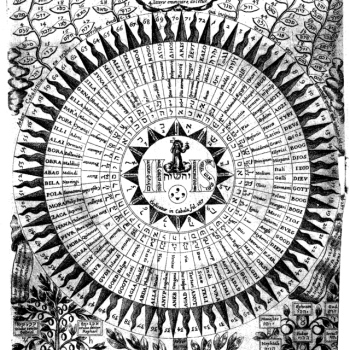![e Apostle John and Marcion of Sinope by Unknown (Life time: 1100?) [Public domain], via Wikimedia Commons](https://wp-media.patheos.com/blogs/sites/637/2016/10/Apostle_John_and_Marcion_of_Sinope_from_JPM_LIbrary_MS_748_11th_c-224x300.jpg)
It is easy to understand how Marcion, and others like him, could cause so much concern. In a cursory reading of the Old Testament, God seems to be too anthropomorphic, too human, acting not according to the simple, uncreated, unchanging activity expected of God, but with an ever-changing will full of human passions such as anger. How could such an image of God be justified? How could God not only have passions, but be negatively affected by them, so that it appears that he loses his mind to them? Presentation of the wrath of anger of God was one of the many places in which Christians had to deal with this question; indeed, it was often a central place where the question was asked, and then used to discuss other anthropomorphic images of God in Scripture. Christians struggled to find answers to these and similar questions; in doing so, we find two general answers emerged. It is these two approaches which interest us here, because it will highlight a basic fact of the Christian faith: we can and do have radically different opinions with each other, so long as our opinions do not contradict and reject our basic, core doctrines. This is possible only if we engage each other with the love Christ expected of us. Without such love, the difference of even the slightest opinion can end up separating us from each other, turning against each other with such bitterness, that we create all kinds of schism in the body of Christ. The key here it so see that from the earliest Christian era onward such radical differences of opinion existed side by side in the Church, and have been held by holy men and women, saints, without dividing them from each other (indeed, they often worked with and respected each other a great deal despite their differing interpretations of Scripture).
The first approach tried to take the text as literally as possible, to see, for example, the positive value in the notion of anger, to suggest that we need to read it not along the lines of the human passion we know as anger which is volatile and tainted by sin, but rather in line with the nature of God who loves justice. This tradition suggested that we should not incorporate our experiences with our passions into the way God experiences those passion, showing that they even if a passion is being predicated to God, it means something different for him from what it means when predicated to us. The error which has to be avoided is assuming our experience of the passion is what is experienced by God. While the feature is the same, it is qualitatively different in God. We can recognize there is a similarity between what we find in God and in us, but, it could be said, this is because we are made in the image and likeness of God. What we find in us is analogous to what we find in God, which means, it is similar and yet, like all analogies, predicated on a difference which distinguishes how anger is in us and in God. We must keep in mind the radical distinction between God and us in order to appreciate how this changes the implications of anger involved as well.
The other approach suggested that anthropomorphic descriptions of God in Scripture must be read allegorically, typologically or spiritually. That is in and through them, we are being told a truth which we must hold, but we must understand that truth is being presented through metaphors, through poetic diction, and to take the text literally is to misunderstand the text itself. To show God as angry was to indicate that there will be dire consequences for sin, that God set up the world with justice so that vices lead to various punishments. Indeed, in our subjective situation, it is easy than to perceive God as being angry with us when we face those punishments. This suggests that the such metaphors has a basis in our subjective experience, and why texts which use those metaphors can be quite effective in presenting particular truths to those who can appreciate those metaphors. But we must always remember the limits of our subjective experience, that an objective truth lies beyond it, and so the objective truth of God is not found in taking the metaphors literally but as pointers to some objective truth beyond the subjective encounter with it.
In either response, we should note that there are things which are held in common: God is just, God is beyond our comprehension, and we engage God and our descriptions of God in a human fashion. But the question is how qualified we are to read such descriptions, whether or not they are more or less indicative of something real in God, of God and humanity having analogous passions, or if we must read it all as purely metaphoric and authors who suggest God is without passions are more or less correct. There is a large variety of writers and texts who speak on this issue; what will be offered here will only a few of the highlight of the two traditions and how they dealt with the questions which Christians had to face once they accepted the Old Testament as an authentic revelation of God.
Stay in touch! Like A Little Bit of Nothing on Facebook:
A Little Bit of Nothing













